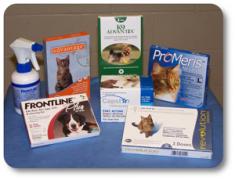What Pet Owners Should Know about Flea and Tick Medications

What Pet Owners Should Know about Flea and Tick Medications
When I was at a recent veterinary conference, I picked up some flyers on flea and tick preventatives. There are now so many products on the market with different combinations of active ingredients that remembering their individual nuances is impossible. The flyers contained tables outlining the ingredients to help me choose the best product for my patients, and I’ll discuss some considerations for pet owners in this blogpost.
Some pet owners might be confused to see a post on flea and tick medications in December, but the Companion Animal Parasite Council recommends year-round treatment of dogs and cats with flea and tick preventative medications, making this a timely topic all year round.
Why Flea and Tick Medications are Necessary for Your Pet
The obvious benefit of flea and tick medication is that they prevent a flea infestation in your home and protect your pet from illnesses transmitted by both ticks and fleas. According to numerous reports, tick populations are booming in the United States, particularly in the Northeast, and tick-borne Lyme disease can be a devastating disease for both humans and animals.
Although this blogpost will discuss some safety considerations around flea and tick medications, these preventatives are critical for your pet’s health, and they are overwhelming safe when prescribed and administered appropriately. The flea and tick medications on the Companion Animal Parasite Council’s Product Reference list are chosen by experts in the field and are approved by a United States government regulatory agency to ensure safety.
What are the Active Ingredients in Flea and Tick Medications?
Flea and tick preventative medications come in multiple classes of drugs: isoxaolines, avermectins, neonicotinoids and phenylpyrazoles. All these drugs affect the nervous system of their target parasite, incapacitating the critters and preventing transmission of an infectious disease to your pet. By combining multiple active ingredients in one product, veterinarians can target multiple parasites, such as fleas, ticks, heartworms and intestinal parasites. Your veterinarian will help you chose the best single product or combination of products to protect your pet against the parasites common in your region.
Who Regulates Flea and Tick Medications?
Two government agencies regulate flea and tick preventative medications. If you put the medication ON your pet, it is regulated by the Environmental Protection Agency (EPA). Flea mousse, sprays and collars fall under the EPA’s regulations. If you put the medication IN your pet, it is regulated the United States Food and Drug Administration (FDA). Oral tablets administered monthly or quarterly fall under the FDA’s regulations. The same ingredient might be in a collar or pill and thus regulated by two different government agencies. This distinction is important to pet owners because you should know which agency is responsible for reporting and recalls in the event of adverse reactions to your pet’s medication.
Isoxazoline Flea and Tick Products and Seizures
In August of 2021, the FDA issued a warning about drugs in the isoxazoline class of flea and tick preventatives regarding “the potential for neurologic adverse events in dogs and cats.” While these drugs have been proven safe and effective, if your pet has a history seizures or other neurologic disorders, AMC’s Neurology Service recommends you discuss the risk and benefit of using drugs in isoxazoline class for preventing fleas and ticks. Since most flea and tick preventative medications contain multiple active ingredients, it’s especially important to remind your veterinarian of your pet’s medical conditions if your veterinarian recommends a new flea and tick preventative.
How to Use Flea and Tick Preventative Safely
Here are a few quick tips on flea and tick safety prevention.
- Use dog products for dogs and cat products for cats. Flea and tick medications are not interchangeable between species.
- Don’t dose your small dog by using half of your big dog’s dose. These medications are formulated as “one dose – one pet” and are prescribed in specific dosages based on each pet’s weight.
- Don’t use your adult dog’s preventative for your new puppy even if they have the same body weight. Most flea and tick medications have an age minimum for the first dose, and varying from this minimum age can be harmful to your pet.
Of course, I’m biased, but I’m of the opinion that using flea and tick preventatives exactly as prescribed by your veterinarian gives you assurance that the medication is being administered safely and effectively in your pet.
If you think your pet is having an adverse reaction…
If you think your pet is having a reaction to a flea and tick preventative medication, the United States Food and Drug administration has information on how to report an adverse reaction.

































